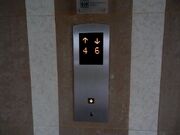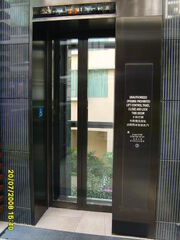| Mitsubishi Elenessa | |
|---|---|
|
Manufacturer |
Mitsubishi Electric Corporation |
|
Production |
2001-present |
|
Type |
Low to mid-rise machine room less traction (MRL) elevator |
Mitsubishi Elenessa is the current machine room less elevator model produced by Mitsubishi Electric and Shanghai Mitsubishi. It was introduced in October 2001[1] as a successor of Mitsubishi GPQ and was later succeeded by NEXIEZ-MRL in 2011[1].
Overview

On Elenessa elevators, the control board is hidden behind the top floor hall station, and there is a lock below the call button to unlock the control board.

For the Code of Practice[2] reason. Hong Kong, China is the only country contains larger cabinet which require to implement the main power supply switch and security camera monitor with the original compact control board console.
Elenessa is a standard machine room less elevator model sold for overseas market with thin permanent magnet (PM), synchronous cylindrical machine installed on the top of the hoistway. This machine has a joint-lapped core technology which produces high-density magnetic fields and able to lower the energy use as well as reducing CO2 emissions. Other features of the machine are unique stator-core structure and built-in double brakes.
The slim control board features a VVVF inverter, high-accumulation LSI, and low-noise PWM inverter. It is installed inside the hoistway near the PM machine. There is also an Integrated Power Unit (IPU) which acts as a high-efficient power supply circuit for the machine drive. Unlike any other machine room less models, the control board is positioned in a box in the wall behind the hall station on the top floor[3], so as not to compromises the aesthetic of the hall[4]. The top floor hall station has a lock which is used to unlock the control board[5].
Elenessa complies with EN81-20:2014, EN81-50:2014 and other codes such as Hong Kong's Code of Practice[6] (which is stricter than those standard) except North America (which doesn't complied to ASME A17.1)[7].
Versions
These are the versions of Elenessa which are currently and/or have been produced by Mitsubishi.
Elenessa Series-IP
This is the earliest version of Elenessa.
Specs:
- 630-1600 (or 8-21 persons) kg rated load
- 1 / 1.6 / 1.75 m/s rated speed
- Maximum floors:
- 22 (for 1 m/s speed with 630, 825, 1050, 1275 and 1600 kg capacity)
- 26 (for 1.6 and 1.75 m/s speed with 1275 and 1600 kg capacity)
- 30 (for 1.6 and 1.75 m/s speed with 630, 825 and 1050 kg capacity)
- Maximum travel height:
- 60 m (for 1 m/s speed with 630, 825, 1050, 1275 and 1600 kg capacity)
- 70 m (for 1.6 and 1.75 m/s speed with 1275 and 1600 kg capacity)
- 80 m (for 1.6 and 1.75 m/s speed with 630, 825 and 1050 kg capacity)
- Operating system
- 1 car, selective collective 1C-2BC (standard)
- 2-4 cars, group control with (Sigma)AI-22 System (optional)
- Center or two speed telescopic side opening doors
- Can have two entrances
Elenessa Series-IP/AP
In 2006, the Elenessa model was upgraded into Series-IP/AP. IP series is manufactured in Mitsubishi Inazawa Works in Japan while AP series is manufactured in Thailand.
Elenessa Series-IP/AP Version 2
The Elenessa Series-IP/AP was upgraded in 2009 into Version 2. This version received several new features, such as regenerative converter (optional), energy saving features (examples; reduced numbers of cars, allocation control, car light/fan shut off, etc.), variable traveling speed elevator system (VSE, optional), and DOAS destination dispatch as an option. It is also equipped with AI (Artificial Intelligence) Neural Network technology, divided into two basic group control systems; (Sigma)AI-22 System (for 2-4 cars in each group, for small to medium-size buildings) and (Sigma)AI-2200C (for 3-8 cars in each group, for large buildings). For Series-IP, it received an extended rated capacity from 1600 kilograms to 2500 kilograms.
Like the previous version, Version 2 complies with EN81-1 and other codes.
Specs:
- Capacities:
- 630-2500 kilograms (or 8-33 persons) for Series-IP
- 450-1600 kilograms (or 6-21 persons) for Series-AP
- 1/1.6/1.75 meters per second speeds
- Serves up to 30 floors
- Up to 80 meters of travel height
- Up to 8 cars group control
- Center or two speed telescopic side opening doors
- Can have two entrances
- DOAS as an optional feature
Nowadays Mitsubishi only produce Elenessa Series-IP Version 2 which have larger capacities.
Specs:
- 1800, 2025, 2250 and 2500 kilograms of rated load
- 1 / 1.6 / 1.75 m/s rated speed
- Serves up to 22 floors
- 60 meters of maximum travel height
- Up to 8 cars group control
- Center or two speed telescopic side opening doors
- Can have two entrances
- DOAS as an optional feature
Elenessa Series-IP/AP Version 3
Identical to Version 2 (see above), but it has rated capacity from 450 kilograms to 1600 kilograms. This version is only sold in certain Asian countries.
Specs:
- 450 / 550 / 630 / 825 / 1050 / 1275 / 1600 (or 6 / 7 / 8 / 11 / 14 / 17 / 21 persons) kg rated load
- Speeds
- 1 / 1.6 / 1.75 m/s for 450-1600 kilograms capacities
- 2 or 2.5 m/s for 825-1600 kilograms capacities
- Serves up to 30 floors
- Up to 8 cars group control
- Center or two speed telescopic side opening doors
- Can have two entrances
- DOAS as an optional feature
Shanghai Mitsubishi Elenessa
Elenessa is also manufactured by Shanghai Mitsubishi. This model is pretty much the same as the one manufactured by Mitsubishi Electric.
Specs:
- 320 / 450 / 550 / 630 / 825 / 1050 / 1275 / 1600 (or 6 / 7 / 8 / 11 / 14 / 17 / 21 persons) kg rated load
- 1 / 1.6 / 1.75 m/s rated speed
- Maximum floors:
- 11 (for 1 m/s speed with 320 kg capacity)
- 20 (for 1 m/s speed with 450 or 550 kg capacity)
- 20 (for 1 m/s speed with 450 or 550 kg capacity)
- 22 (for 1 m/s speed with 630, 825, 1050, 1275 or 1600 kg capacity)
- 22 (for 1.6 and 1.75 m/s speed with 450 or 550 kg capacity)
- 26 (for 1.6 and 1.75 m/s speed with 1275 or 1600 kg capacity)
- 30 (for 1.6 and 1.75 m/s speed with 630, 825 or 1050 kg capacity)
- Up to 8 cars group control
- Center or two speed telescopic side opening doors
- Can have two entrances
Signal fixtures
The design of the fixtures for early Elenessa (and also ELEPAQ-i in Japan) elevators installed from 2001 to early 2010s have been changed drastically. The font of the number on the button has been changed from Helvetica to Gill Sans Medim. The buttons are now barrel shaped, colored black and has orange illuminating tactile legend to make it easier to operate by the visually-impaired people. The door open button has been enlarged 1.6 times to prevent confusion with the door close button. In addition, although the LED dot matrix display (which has been used since the GRANDEE model was launched in 1990) is continuously used for the floor indicators, the size of the letters has been enlarged 1.6 times except for those found on the car station for the wheelchair, making it easier to see. For elevators with the car station installed on the side wall, the alarm button is positioned in one row with the door control buttons below the floor buttons. The button for main/exit floor is green and raised about 5 mm than the rest of the buttons. Mitsubishi introduced this design as "Universal Design" and it is also used in NexWay series. This design is also used on Elenessa elevators manufactured by Shanghai Mitsubishi.
In 2013, Elenessa received a new design of fixtures which is also currently used on the NEXIEZ series. The buttons are now round stainless steel with tactile and yellow orange illumination. In addition of yellow orange, a blue and white illuminations have also been added for the buttons. Indicators now uses LED segmented display as standard, although the LED dot matrix and LCD ones are also used as an option. For car station installed on the side wall, it follows the same configuration found in Elenessa and NexWay models; the alarm button is positioned in one row with the door control buttons below the floor buttons. There is no green button for the main/exit floor, except in European countries where it is mandatory[8].
Notable Elenessa installations
Thailand
- Mega Bangna, Samut Prakarn (Robinson Dept. Store) (2012)
- Chamchuri Square, Bangkok (2008)
- Terminal 21 Asoke, Bangkok (2011)
- The Third Place Club, Bangkok
- BIS Building, Bangkok (Phase 3)
- The St. Regis Bangkok, Bangkok (Carpark elevators)
- The Old Siam Plaza, Bangkok (Service elevator)
- ChinaWorld, Bangkok
- Sethiwan Plaza, Bangkok
- CentralPlaza Grand Rama 9, Bangkok (Robinson Dept. Store) (2011)
- Wat Traimit, Bangkok
- Dang Derm Hotel, Bangkok
- Robinson Lifestyle Center Saraburi, Saraburi
- Wat Ban Rai, Nakhon Ratchasima
- CentralFestival Pattaya Beach, Chonburi (Central Dept. Store) (2009)
- CentralPlaza Chaengwattana, Nonthaburi (Central Dept. Store) (2009)
Indonesia
- Lotte Shopping Avenue - Ciputra World Jakarta (2012)
- The 101 Dago, Bandung (2014)
- The 101 Tugu, Yogyakarta (2013)
- Juanda International Airport, Surabaya
- The ONE Legian (formerly The 101 Legian), Bali (2011)
- Rhadana Kuta Hotel, Bali
- The Spot Legian Hotel, Bali
- FRii Canggu Echo Beach Hotel, Bali (2013)
Other Countries
- Marina Square, Singapore (2006)
- Tan Son Nhat International Airport, Ho Chi Minh City, Vietnam (2007)
- Wanchai Market, Wan Chai, Hong Kong, China (2008)
- The Zenith, Wan Chai, Hong Kong, China (2006)
Notable Shanghai Mitsubishi Elenessa installations
- Shanghai Pudong Airport Terminal 2, Shanghai, China (2006)
- Some stations in Shanghai Metro network, Shanghai, China
- Chong Pang Community Centre, Singapore
- Bellagio Shopping Arcade, Jakarta, Indonesia (2005)
- Mall of Indonesia, Jakarta, Indonesia
Videos

Mitsubishi MRL Elevator at Rhadana Hotel Kuta, Bali
Mitsubishi Elenessa traction elevator at Rhadana Hotel Kuta, Bali, Indonesia
See also
- Mitsubishi Diamond Trac - machine room less elevator in the United States that is similar to Elenessa.
Notes and references
- ↑ 1.0 1.1 Milestones
- ↑ "Code of Practice on the Design and Construction of Lifts and Escalators" (《升降機及自動梯設計及構造實務守則》), Electrical and Mechanical Services Department, HKSAR, People's Republic of China.
- ↑ Mitsubishi Elevator - Behind The Call Buttons(Top)
- ↑ Mitsubishi Electric ADVANCE Vol99
- ↑ This except Hong Kong version which require to implement the main power supply switch and security camera monitor.
- ↑ "Code of Practice on the Design and Construction of Lifts and Escalators (2012 Edition)" (《升降機及自動梯設計及構造實務守則》(2012年版)), Electrical and Mechanical Services Department, HKSAR, People's Republic of China.
- ↑ Selecting Available Products (Simplified Chinese version), Mitsubishi Electric Corporation.
- ↑ Mitsubishi Passenger Lifts Design Guide brochure (for European standards)
External links
- Elenessa
- Elenessa (Mitsubishi Elevator Thailand)
- Elenessa Series-AP Version2 brochure (archived)
- Elenessa Series-IP brochure (archived)
- Elenessa Series-IP Version2
- Elenessa Series-IP Version2 brochure (2011 edition)
- Elenessa Series-IP Version2 brochure (latest edition)
- Elenessa Series-IP Version3 brochure
- Shanghai Mitsubishi Elenessa brochure (archived)
- Mitsubishi Electric Advance Volume 99 - Elevator and Escalator Edition

|
"This elevator only serves two floors." This article is a stub. You can help Elevatorpedia by expanding it. |